
Sea Surgeon's Dispensatory: 1 2 3 4 5 6 7 8 9 10 11 12 13 14 15 16 17 18 19 20 21 22 23 24 25 Next>>
The Sea Surgeon's Dispensatory, Page 11
Sea Surgeon Concerns
Sea surgeons had a particular set of concerns about the medicines they used that were in some ways unique to them and their situation.
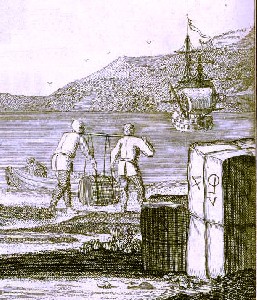
Artist: Joseph Nicholls
Loading the Ship, From "Capt. Teach, Commonly Call'd
Black
Beard", The General History of the Pyrates (1736)
The first concern of sea surgeons relative to pharmacy concerned the appropriateness of the medicines they had on hand for sailors. Several factors that could effect a medicines appropriateness - the sorts of health problems commonly found in men at sea, what the men might contract when the ship stopped in port and what medicines could best handle the most illnesses.
The second concern of a sea surgeon relative to pharmacy was in being sure the medicines they purchased for their chest were what they had ordered. Unlike land-based practitioners, the sea surgeon had no recourse if the medicines he received in port were inferior or adulterated.
A third concern for a sea surgeon was how much of the different types of medicines they would need to bring with them. The sea surgeon needed to have enough of the various medicines to last the voyage without having too much left over at the end.
Last, and perhaps most important in some ways, were how long medicines would keep. The sea-surgeon faced the problem of most of his fresh ingredients going bad after a few weeks at sea without being able to obtain replacements in the near future. So he had to make sure the medicines he purchased before the voyage would maintain their potency for as long as possible.
Let's look at these four concerns in detail.
Sea Surgeon Concerns - Appropriateness of Medicines
"First, In your fitting you are to consider what accidents and distempers do most commonly happen to men at Sea, more especially, which of those are most incident to the Country or Climate you are bound unto; or the present Expedition you are upon; to the end you may furnish your self with Druggs and Medicines accordingly." (John Moyle, The Sea Chirurgeon, 1693, p. 2)
Since sea surgeons had to limit the amount and types of drugs they brought with them, they had to be sure that the medicines they chose were appropriate to their task. If too many men were ill and couldn't be cured quickly enough, a ship would not be able to be effectively sailed or defended.
An attack on Martinique 
Artists: Thomas Rowlandson and Augustus Charles Pugin
Microcosm of London, Plate 003 - Board Room of the Admiralty (1808)
by the British Navy in 1693 had to be abandoned because of sickness and death among the sailors. "This abortive expedition ...cost the country the death of
upwards of a thousand officers and men by disease, while not
more than a hundred and twenty had fallen by the hands of
the enemy."1 Another expedition to the same region in 1695 "lost so many men to disease
that several severely undermanned ships went down at sea before they could get home."2
As a result, the British Navy Admiralty asked the College of Physicians "to recommend ‘a scheme of severall species of Medicines, which in your opinion are most proper for the care of the sick and wounded men in the fleet’, with instructions on how much of each medicine should be supplied in a chest for the care of 200 men."3 The Admiralty felt "the issue was the supply of medicines that would work to cure the diseases suffered by the sailors."4 Clearly they felt that medicines appropriate to the conditions at sea were needed.
Sea surgeon John Moyle points out the two environments where sailors faced particular health problems - during the voyage and immediately after leaving their destinations. He also makes a pitch for compounded medicines, feeling they were the most convenient and appropriate forms for use at sea.
1 William Laird Clowes, The Royal Navy: a history from the earliest times to the present, 1898, vol. 2, p. 471; 2 Harold J. Cook, "Practical Medicine and the British Armed Forces After the ‘Glorious Revolution," Medical History, 1990, 34, p. 4; 3,4 Cook, p. 13
Sea Surgeon Concerns - Appropriateness of Medicines - At Sea
Moyle noted that "there are some distempers [which are] more usual at Sea than others, (as Fevers, Fluxes, Scurvy, Wounds, Contusions, Fractures) and there ought in a more especial manner to be provided for."1 While the last three issues were the sort of wounds that could be expected to be found in almost any working environment; fevers, fluxes and scurvy were different matters.
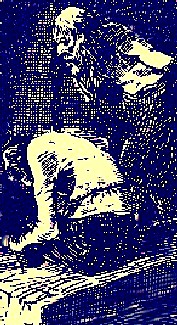
From Captain William Kidd and
Others,
by John S. C. Abbot, p. 270 (1834)
Fevers have a frequent association with the sea in surgeon's manuals. Moyle focuses on calentures (a type of feverish delirium) which were "very frequent at Sea, especially in hot Clymates. I have had the woful experience of them, (as well as of Fluxes) at Scanderoon [Iskenderun,Hungary], and Cypris"2. He notes that at sea, calentures can be contracted "by lying in the cold, the pores of the Body being open, and so letting in the Air, and putrifying the Humours"3. William Dampier suggested that fevers could be caused by hardships of a voyage.4 Sea surgeon John Woodall attests to likelihood of fevers at sea by choosing dozens of medicines for treating fevers as we shall see.
Fluxes (diarrheas and dysenteries) were clearly considered a problem at sea. Both Moyle and John Woodall devote an entire chapter to the problem in their books written for sea surgeons.5 Naval physician William Cockburn thought so much of the problem he published an entire book on the topic called The Nature and Cure of Fluxes in 1724.
Of course, scurvy is the disease most often associated with the sea. While scurvy was not unknown on land, it was much more likely to occur in the isolated world of a ship after the fresh fruits and vegetables had run out. As a result, it was considered the scourge of extended sea travel at this time and something the surgeon had to be ready to treat.
Curiously, the correct cure for scurvy seemed to be recognized by many physicians and surgeons at this time. For example, John Woodall says that "the juice of Lemons is a precious medicine and wel tried [for curing scurvy],
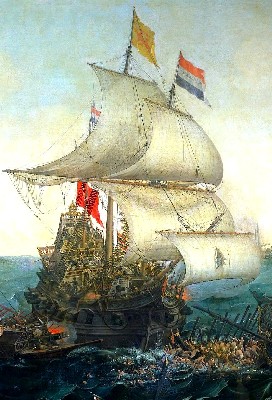
Artist: Hendrik Cornelisz Vroom
Dutch Ships Running Down Spanish Galleys (1617)
being sound & good, let it have the chiefe place for it will deserve it"6. Moyle similarly advises that he'd never seen scurvy on a ship which "had ...green Trade, and Fruits"7. However, such cures were buried among a variety of other incorrect medicines and theories. Woodall recites a laundry list of suggested cures and medicines for scurvy which takes 10 pages to recite.
John Moyle also suggests that the health problems experienced by a ship underway depended on the place where the ship was sailing. When traveling northward, he advised that "there are more of Agues [malarial fevers] and the Scurvy; and to the Southward more of Fluxes and Fevers"8. He suggested that the surgeons heading north to "carry good store of Antiscorbuticks [anti-scurvy medicines], Diaphoreticks [medicines to cause sweating to 'sweat out' bad humors], and comfortable cordials [soothing medicines, usually containing alcohol]."9 For those headed south, "you must have more of Dysentericks [medicines to cure dysentery], Antifebriticks [medicines to combat fevers], and refreshing Juleps [sweet, syrupy drinks]."10
With regard to wounds, contusions and fractures, Moyle says "whenever a Ship goes you may expect wounds and disasters (especially if in time of War) so that here you must preheminently mind to carry good Astringents [medicines to draw tissues together and stop bleeding], Digestives [medicine to promote the growth of flesh in a wound], and other Vulneraries [wound healing medicines]."11
1 John Moyle, The Sea Chirurgeon, 1693, p. 2; 2 John Moyle, Abstractum Chirurgæ Marinæ, p. 115; 3 Moyle, Sea Chirurgeon, 1693, p. 159; 4 William Dampier, Memoirs of a Buccaneer, Dampier’s New Voyage Round the World -1697-, p. 334; 5 See Moyle, Sea Chirurgeon, 1693, p. 169-78 and John Woodall, the surgions mate, 1617, p. 202-16; 6 Woodall, p. 185; 7 Moyle, Sea Chirurgeon, 1693, p. 181; 8,9,10 Moyle, Sea Chirurgeon, 1693, p. 2-3; 11 Moyle, Sea Chirurgeon, 1693, p. 3
Sea Surgeon Concerns - Appropriateness of Medicines - In Port
Health issues arising at the ports where the ship stopped was another, completely separate concern for a sea surgeon. Having the men from a ship interacting with locals risked contracting illnesses that those in a port were carrying. As one author puts it, "Putting into shore was also dangerous because of the likelihood of contracting fevers and dysentery."1

Artist: Adrien Mangiard
Ship in Mediterranean Port (1740s)
Sea surgeon John Atkins reported a "epidemical malignant Fever' that ran rampant among the men of the Weymouth and Swallow while stopping at Isle Del Principe in 1721. Within two months it had so decimated the crews that it led "to some Deliberations whether we could proceed to Sea safely without a return of Men from England [bringing more men in to take over for the sick crew2]; the Weymouth not being able to purchase [haul up3] her Anchors, and we in the Swallow with difficulty."4 Captain Charles Johnson reports that "they buried 100 Men in three Weeks time, and reduced the Remainder of the Ships Companies into so sickly a state, that it was with Difficulty they brought them to sail"5.
Of course, health problems in port were not limited to illnesses picked up by casual encounters. As Joan Druett explains, when a ship stopped in port, "Men swarmed ashore to eat local food, quaff local liquor, drink local water, and sleep with local women."6 From this, they no doubt brought back intestinal parasites, diarrheas, and venereal diseases. A variety of medicines were needed to treat such problems.
On the plus side, while a ship was in port, the men could seek treatment there and the sea surgeon could obtain local medicines to replenish his supply. However, the larger issue was when the men, having been on shore and gotten exposed to various local health problems, brought those health problems back on board the ship and took them to sea. Once a ship had sailed, the disease had to be treated by the surgeon with the medicines he had on board.
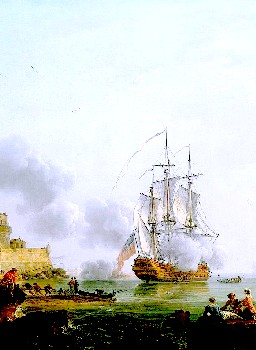
Artist: Claude Joseph Vernet
Ship Firing Salute at Harbor Entrance (1761)
Worse still, if the illness was communicable, the surgeon had to stop its spread before it could infect the rest of the crew. A particularly virulent disease could decimate the population of the little wooden world, making it impossible for the men to sail their ship.
When Woodes Rogers' privateering fleet stopped in Guayaquil in 1709, they picked up such an illness. Physician Thomas Dover reported,
In a very few Days after we got on Board, one of the Surgeons came to me to acquaint me, that several of my Men were taken after a violent Manner with that Languor of Spirits, that they were not able to move. I immediately went among them, and, to my great Surprize, soon discerned what was the Matter. In less than forty eight Hours we had in our several Ships one hundred and eighty Men in this miserable Condition.7
As Dover notes, if their fleet had "lost so great a Number of our People, the poor Remains [of the crews] must infallibly have perished."8
Dover first thought it was the plague, but later decided it was "no more than a Fever of the most exalted Kind"9. He first bled the men, then noting that they "had on Board Oil and Spirits of Vitriol sufficient; which
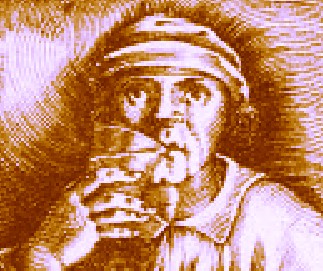
Artist: Jan van der Straet (1600)
I caused to be mixed with water to the Acidity of a Lemon and made them drink very freely of it; so that notwithstanding we had one hundred and eighty odd down in this most fatal Distemper, yet we lost no more than seven or eight"10.
So a ship's doctor had to be as prepared as possible, having the medicines ready that he might need when the ship set sail from a destination.
Moyle gives some guidance in this area as well. In addition to his comments mentioned the previous section on the prevalence of health problems associated with northern and southern climates, Moyle adds that "in the cold Countries there happens more of Catarrhs [mucus build-up, possibly referring to colds] and Numbness, and therefore good Pectorals [expectorants - medicines to relieve the respiratory tract of mucus] and strong Foments [warm, medicated lotions to reduce pain and inflammation] are required; whereas in hot Countries Epidemical diseases abound, and there Alexiteries [medicines that resist contagions] are absolutely needful."11
1 Stephen R. Bown, Scurvy: How a Surgeon, a Mariner, and a Gentleman Solved the Greatest Medieval Mystery of the Age of Sail, 2003, p. 44; 2 Thanks to Ed Fox for verifying my interpretation; 3 Thanks to Casey Duckett for verifying my interpretation of this; 4 John Atkins, A Voyage to Guinea, Brazil and the West Indies, 1735, p. 139; 5 Captain Charles Johnson, A general history of the pirates, 3rd Edition, p. 262; 6 Joan Druett, Rough Medicine: Surgeons at Sea in the Age of Sail, 2000, p. 134; 7 Thomas Dover, The Ancient Physician's legacy, 1733, p. 67; 8,9,10 Dover, p. 68; 11 John Moyle, The Sea Chirurgeon, 1693, p. 3
Sea Surgeon Concerns - Appropriateness of Medicines - Compounded Medicines
John Moyle also suggested the surgeons rely on compound medicines - those consisting of a variety of simples combined into one medicine. He explained that the sea surgeon would be wise to have the "kind of Medicines are of the most universal tendency in curing of the Maritime diseases and casualties before specified, to

Artist: Michel-Charles Coquelet-Souville
Claude Morelot's Pharmacy (1751)
the end you may take more of such, than of them which are for only one disease and no more."1 Moyle reasoned that the medicine chest contained "all the room you can expect to carry Medicines in, therefore it behoves you to put up only them that are most catholick [comprehensive] import, one of which will serve to cure several diseases."2
A problem with compound medicines is that they came with baggage - compounds were often associated with quacks who promoted such cure-alls and tarnished the reputation of apothecaries and physicians. In fact, this was a point of contention between the Admiralty and the College of Physicians after the disasters in Martinique that were discussed at the beginning of the section. The Admiralty "wanted specific [compound] medicines, the kind of medicines the physicians associated with quackery: good for a specific disease in all cases whatsoever, no matter what the age, temperament, or circumstances of the patient and the precise moment a which the ever-changing manifestations of the illness was found."3
Here we again face the problem of the validity of the polypharamacueticals discussed in the section Medicine Use: Forms. Since the sea surgeons were not trained as rigorously in the use of medicines and were also faced with the problems of limited space and more pressing operations to handle, many of them preferred something easy to remember and apparently reliable over something more complex and elegant.
For example, Moyle explains that "among Syrups; that of de spina Cervina, and the other of Rosaceus Solut. cum Senna, being they purge all humours, are more fit to be put up than others. The like of Pills, that of extractum rud. i, and the other of ex duobus, purge whatever any other Pills can do (as to humours). Therefore these, and such as these, are fitter to be carried by the Sea Surgeon, than others that were designed for particular humours; and that because you have not stowage for all."4
As a result of this sort of thinking, we find significantly more compound medicines in the Sea Surgeon's Dispensatory than simples and chemical medicines combined.
1,2 John Moyle, The Sea Chirurgeon, 1693, p. 3; 3 Harold J. Cook, "Practical Medicine and the British Armed Forces After the ‘Glorious Revolution," Medical History, 1990, 34, p. 13; ,4 Moyle, p. 4

